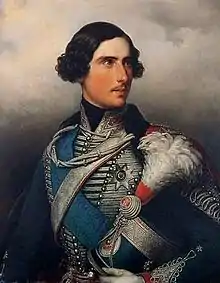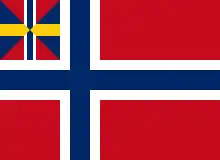Prince Frederick William of Hesse-Kassel
Frederick William George Adolphus, Landgrave of Hesse (German: Friedrich Wilhelm Georg Adolf von Hessen-Kassel; 25 November 1820 – 14 October 1884) was the only son of Wilhelm I, Landgrave of Hesse-Kassel-Rumpenheim and Princess Louise Charlotte of Denmark.[1]
| Frederick William II | |
|---|---|
| Landgrave of Hesse | |
 | |
| Born | 26 November 1820 |
| Died | 14 October 1884 (aged 63) |
| Spouse | |
| Issue | Prince William Frederick William III, Landgrave of Hesse Elisabeth, Hereditary Princess of Anhalt Alexander Frederick, Landgrave of Hesse Frederick Charles, Landgrave of Hesse Princess Marie-Polyxene Sybille, Baroness Friedrich of Vincke |
| House | Hesse-Kassel |
| Father | Prince William of Hesse-Kassel |
| Mother | Princess Louise Charlotte of Denmark |
Early life and marriages

He was born in Copenhagen, moved to Denmark at the age of three, and grew up there. He attended the university in Bonn, and then began a military career. In 1843 he was third in line for the Danish throne after the King's son and brother, Prince Ferdinand.[2] His siblings included Louise of Hesse-Kassel, future Queen of Denmark, Princess Marie Luise Charlotte of Hesse-Kassel and Princess Auguste Sophie Friederike of Hesse-Kassel.
On 28 January 1844, Frederick married Grand Duchess Alexandra Nikolaevna of Russia at St Petersburg. Frederick had come to St Petersburg as a prospective bridegroom for her sister Olga, but fell in love with Alexandra instead on the first evening he spent with the family. Although Olga was the elder daughter and also found Frederick to be an engaging young man, she stepped aside in favour of her sister, and even chaperoned the couple when they wanted to spend time together. The emperor and empress then gave their permission for Alexandra and Frederick to be married.
Alexandra became acutely ill with tuberculosis shortly before her wedding, and this complicated the pregnancy which soon followed. She was never well enough to travel to Hesse and take up her new position with her husband. They stayed in St. Petersburg, where her health rapidly declined. She went into labor prematurely, three months before the child was due, and gave birth to a son, Wilhelm. The infant died shortly after he was born, and Alexandra died later the same day. Her parents were devastated and their grief would last until the end of their lives. She was buried at the Peter and Paul Fortress in St. Petersburg. The son was buried in Rumpenheim, now a borough of Offenbach am Main, Germany.[3]
In 1849 Frederick William joined HMS Cleopatra to train as a midshipman. The Cleopatra was reassigned to Singapore to take the place of HMS Maeander.[4] She arrived in Singapore from Devonport via Rio de Janeiro under Captain Massie on 14 September 1849 and left with HMS Reynard for Labuan and China on 10 October. The Singapore paper mistakenly described the Prince as the son of the Danish king but the king had no sons, he was an heir to the throne.[5][6]
On 26 May 1853, Frederick married Alexandra's first cousin, Princess Anna of Prussia (1836–1918), at Charlottenburg Palace in Berlin. Although they had six children together, Frederick and Anna were never emotionally close, and it is speculated that one reason was because Fritz was unable to overcome his grief for his first wife.
Children
His first wife was Alexandra Nikolaevna of Russia (1825–1844), daughter of Emperor Nicholas I of Russia and Charlotte of Prussia.[1] Alexandra died in childbirth, delivering a son who was born three months prematurely, and who died on the day of his birth:
- Prince Wilhelm (1844–1844)
His second wife was Princess Anna of Prussia (1836–1918), the youngest daughter of Prince Charles of Prussia and Princess Marie of Saxe-Weimar-Eisenach.[1] They had six children:
- Prince Frederick William III of Hesse (1854–1888); never married; died at sea on a voyage from Batavia to Singapore.
- Princess Elisabeth Alexandra Charlotte of Hesse (1861–1955); married Leopold, Hereditary Prince of Anhalt in June 1884 and had issue.[7]
- Prince Alexander Frederick of Hesse (1863–1945); married Baroness Gisela Stockhorner von Starheim.
- Prince Frederick Charles of Hesse, King of Finland (1868–1940); married Princess Margaret of Prussia and had issue.
- Princess Marie-Polyxene of Hesse (1872–1882).
- Princess Sybille Marguerite of Hesse (1877–1925); married Friedrich Alexander Henry Robert Carl Albert, Baron von Vincke (divorced 1923).
Elector of Hesse
He is important dynastically as a candidate for both the headship of the Hesse-Kassel dynasty (through his father) and for the Danish throne (through his mother). When Frederick William, deposed Elector of Hesse died in 1875, his sons were excluded from succession, because of his morganatic marriage. Therefore, Frederick succeeded him as titular Elector of Hesse.
Frederick William died on 14 October 1884 at Hamburg.[1]
Honours and awards
Friedrich Wilhelm received the following awards:[8][9]
- German decorations
 Hesse-Kassel: Grand Cross of the Golden Lion, 29 April 1840[10]
Hesse-Kassel: Grand Cross of the Golden Lion, 29 April 1840[10] Hesse and by Rhine:[11]
Hesse and by Rhine:[11]
- Grand Cross of the Ludwig Order, 7 September 1850
- Grand Cross of Philip the Magnanimous, with Swords, 18 January 1870
- Military Merit Cross, 8 March 1871
- Bronze Medal for the Campaign in France (1870-1871)
 Ascanian duchies: Grand Cross of Albert the Bear, 22 April 1857[12]
Ascanian duchies: Grand Cross of Albert the Bear, 22 April 1857[12].svg.png.webp) Baden:[13]
Baden:[13]
- Knight of the House Order of Fidelity, 1875
- Grand Cross of the Zähringer Lion, 1875
.svg.png.webp)
.svg.png.webp)
.svg.png.webp) Ernestine duchies: Grand Cross of the Saxe-Ernestine House Order, 1871[14]
Ernestine duchies: Grand Cross of the Saxe-Ernestine House Order, 1871[14] Mecklenburg:
Mecklenburg:
- Grand Cross of the Wendish Crown, with Crown in Ore
- Military Service Cross, 2nd Class (Schwerin)
.svg.png.webp) Nassau: Knight of the Gold Lion of Nassau, September 1858[15]
Nassau: Knight of the Gold Lion of Nassau, September 1858[15] Oldenburg: Grand Cross of the Order of Duke Peter Friedrich Ludwig, with Golden Crown, 16 September 1869[16]
Oldenburg: Grand Cross of the Order of Duke Peter Friedrich Ludwig, with Golden Crown, 16 September 1869[16].svg.png.webp) Prussia:
Prussia:
.svg.png.webp) Saxe-Weimar-Eisenach: Grand Cross of the White Falcon, 9 June 1853[17]
Saxe-Weimar-Eisenach: Grand Cross of the White Falcon, 9 June 1853[17] Schaumburg-Lippe: Military Merit Medal
Schaumburg-Lippe: Military Merit Medal Württemberg: Grand Cross of the Württemberg Crown
Württemberg: Grand Cross of the Württemberg Crown
- Foreign decorations
 Austrian Empire: Grand Cross of St. Stephen, 1860[18]
Austrian Empire: Grand Cross of St. Stephen, 1860[18] Denmark:
Denmark:
- Knight of the Elephant, 28 June 1840
- Cross of Honour of the Order of the Dannebrog, 28 June 1840
.svg.png.webp) Kingdom of Greece: Grand Cross of the Redeemer
Kingdom of Greece: Grand Cross of the Redeemer Russian Empire:
Russian Empire:
- Knight of St. Andrew, in Diamonds, 1 July 1843
- Knight of St. Alexander Nevsky
- Knight of the White Eagle
- Knight of St. Anna, 1st Class
- Knight of St. George, 4th Class, 1878
.svg.png.webp)
 Sweden-Norway: Knight of the Seraphim, 2 November 1869[19]
Sweden-Norway: Knight of the Seraphim, 2 November 1869[19]
Ancestry
| Titles in pretence | ||
|---|---|---|
| Preceded by Frederick William I |
— TITULAR — Elector of Hesse 1875–1884 |
Succeeded by Frederick William III |
References
- "Deaths of note". The Ipswich Journal. 21 October 1884. Retrieved 22 June 2015 – via British Newspaper Archive.
- "Russia and Denmark". Waterford Chronicle. 2 December 1843. p. 8. Retrieved 22 June 2015 – via British Newspaper Archive.
- "From the London Gazette - Friday 30 August". London Standard. 31 August 1844. p. 1. Retrieved 22 June 2015 – via British Newspaper Archive.
- Reports & C, The Straits Times, 28 August 1849, Page 9
- "Shipping News". The Singapore Free Press and Mercantile Advertiser. Newspapers.nl.sg. 6 November 1849. p. 3. Retrieved 2012-11-15.
- The Straits Times, 16 October 1849, Page 3
- "Untitled". Western Daily Press. 18 February 1884. p. 3. Retrieved 22 June 2015 – via British Newspaper Archive.
- Hof- und Staats-Handbuch des Großherzogs Hessen (1879), Genealogy p. 5
- Bille-Hansen, A. C.; Holck, Harald, eds. (1883) [1st pub.:1801]. Statshaandbog for Kongeriget Danmark for Aaret 1883 [State Manual of the Kingdom of Denmark for the Year 1883] (PDF). Kongelig Dansk Hof- og Statskalender (in Danish). Copenhagen: J.H. Schultz A.-S. Universitetsbogtrykkeri. pp. 3–4. Retrieved 30 April 2020 – via da:DIS Danmark.
- Hof- und Staats-Handbuch des Großherzogs Hessen (1879), "Großherzogliche Orden und Ehrenzeichen" p. 43
- Hof- und Staats-Handbuch des Großherzogs Hessen (1879), "Großherzogliche Orden und Ehrenzeichen" pp. 10, 47, 130
- Hof- und Staats-Handbuch des Herzogtum Anhalt (1867) "Herzoglicher Haus-orden Albrecht des Bären" p. 18
- Hof- und Staats-Handbuch des Großherzogtum Baden (1880), "Großherzogliche Orden" p. 59
- Staatshandbücher für das Herzogtum Sachsen-Coburg und Gotha (1884), "Herzogliche Sachsen-Ernestinischer Hausorden" p. 32
- Staats- und Adreß-Handbuch des Herzogthums Nassau (1866), "Herzogliche Orden" p. 8
- Hof- und Staatshandbuch des Großherzogtums Oldenburg0: 1878. Schulze. 1878. p. 33.
- Staatshandbuch für das Großherzogtum Sachsen / Sachsen-Weimar-Eisenach (1864), "Großherzogliche Hausorden" p. 12
- "A Szent István Rend tagjai" Archived 22 December 2010 at the Wayback Machine
- Sveriges Statskalender (in Swedish), 1881, p. 377, retrieved 2018-01-06 – via runeberg.org
External links
![]() Media related to Frederick William, Landgrave of Hesse-Kassel at Wikimedia Commons
Media related to Frederick William, Landgrave of Hesse-Kassel at Wikimedia Commons

